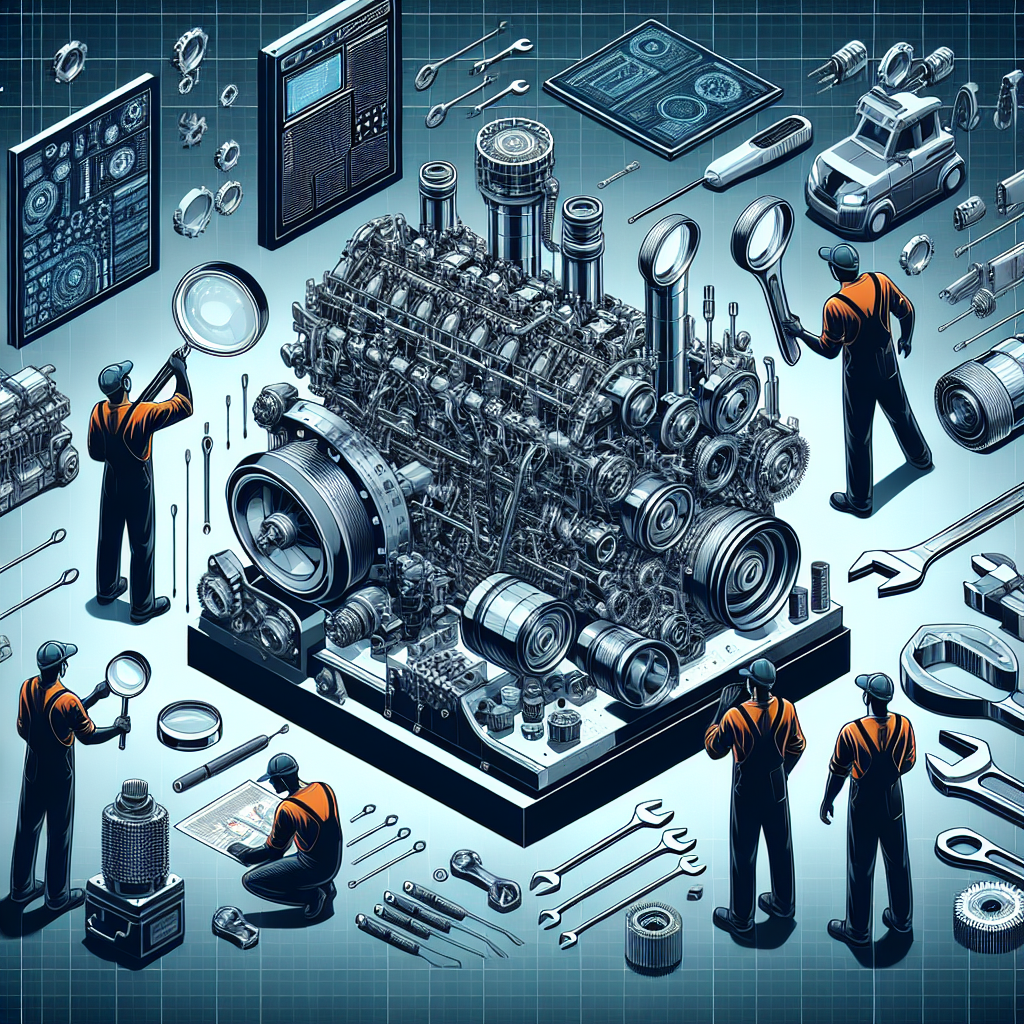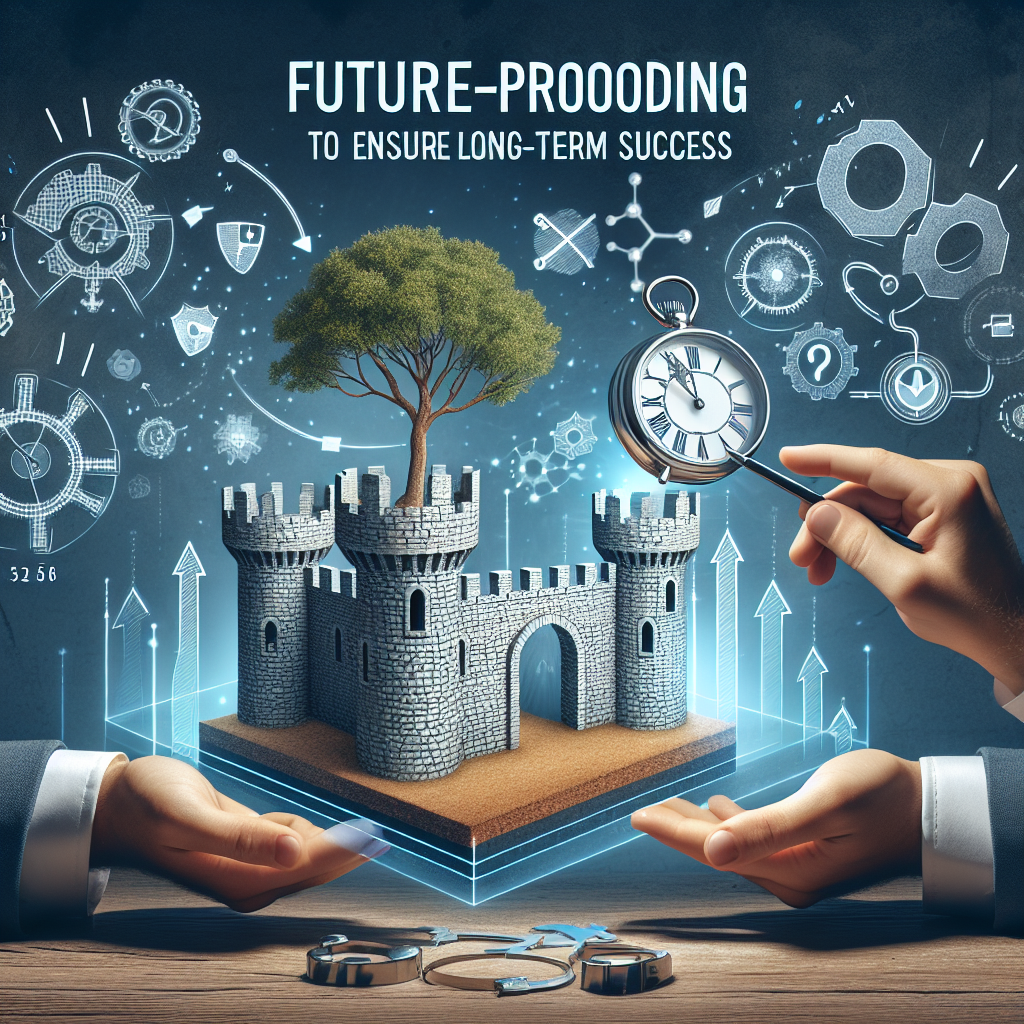Your cart is currently empty!
Tag: LongTerm

Proactive Maintenance Best Practices for Long-Term Equipment Reliability
Proactive maintenance is a key practice in ensuring the long-term reliability of equipment. By implementing proactive maintenance best practices, organizations can prevent breakdowns, reduce downtime, and extend the lifespan of their equipment. In this article, we will discuss some of the best practices for proactive maintenance that can help organizations achieve long-term equipment reliability.1. Develop a maintenance schedule: One of the first steps in implementing proactive maintenance is to develop a maintenance schedule for each piece of equipment. This schedule should outline the frequency of maintenance tasks, such as inspections, lubrication, and calibration, as well as the specific tasks that need to be performed. By following a regular maintenance schedule, organizations can identify and address potential issues before they lead to equipment failure.
2. Conduct regular inspections: Regular inspections are essential for identifying potential issues early on. Inspections should be conducted by trained personnel who are familiar with the equipment and its maintenance requirements. During inspections, personnel should look for signs of wear and tear, leaks, loose fittings, and other issues that could impact the reliability of the equipment.
3. Keep detailed maintenance records: Keeping detailed maintenance records is crucial for tracking the maintenance history of each piece of equipment. These records should include information such as maintenance tasks performed, parts replaced, and any issues that were identified during inspections. By maintaining accurate records, organizations can track the performance of their equipment over time and identify trends that may indicate potential issues.
4. Implement predictive maintenance techniques: Predictive maintenance techniques, such as vibration analysis, thermography, and oil analysis, can help organizations predict when equipment failure is likely to occur. By monitoring key indicators of equipment health, organizations can identify potential issues before they lead to breakdowns and take corrective action to prevent costly repairs.
5. Train maintenance personnel: Proper training is essential for ensuring that maintenance personnel are equipped to perform proactive maintenance tasks effectively. Training should cover topics such as equipment operation, maintenance procedures, and safety protocols. By investing in training for maintenance personnel, organizations can ensure that maintenance tasks are performed correctly and efficiently, leading to improved equipment reliability.
6. Invest in quality parts and materials: Using quality parts and materials is essential for maintaining the reliability of equipment. Low-quality parts can lead to premature failure and costly repairs, while high-quality parts can help extend the lifespan of equipment. Organizations should work with reputable suppliers to ensure that they are using parts and materials that meet the required specifications for their equipment.
In conclusion, proactive maintenance is essential for ensuring the long-term reliability of equipment. By following these best practices, organizations can prevent breakdowns, reduce downtime, and extend the lifespan of their equipment. By developing a maintenance schedule, conducting regular inspections, keeping detailed maintenance records, implementing predictive maintenance techniques, training maintenance personnel, and investing in quality parts and materials, organizations can achieve long-term equipment reliability.

Proactive Maintenance Best Practices for Long-Term Success
Proactive maintenance is an essential aspect of ensuring the long-term success of any business. By implementing best practices for proactive maintenance, companies can minimize downtime, reduce costs, and increase the lifespan of their equipment and assets. In this article, we will discuss some key best practices for proactive maintenance that can help businesses achieve long-term success.1. Develop a maintenance schedule: One of the first steps in implementing proactive maintenance is to develop a maintenance schedule. This schedule should outline when maintenance tasks need to be performed, who is responsible for performing them, and what resources are required. By having a structured maintenance schedule in place, businesses can ensure that maintenance tasks are performed regularly and on time.
2. Conduct regular inspections: Regular inspections are essential for identifying potential issues before they escalate into costly problems. By conducting routine inspections of equipment and assets, businesses can identify wear and tear, leaks, and other issues early on, allowing them to address them before they cause downtime or damage.
3. Implement predictive maintenance techniques: Predictive maintenance involves using technology and data to predict when equipment is likely to fail. By implementing predictive maintenance techniques, businesses can schedule maintenance tasks more efficiently, reduce downtime, and extend the lifespan of their equipment.
4. Train maintenance staff: Proper training is essential for maintenance staff to effectively perform their duties. By providing ongoing training and education to maintenance staff, businesses can ensure that they have the skills and knowledge required to perform maintenance tasks effectively and efficiently.
5. Use technology to streamline maintenance processes: Technology can play a key role in streamlining maintenance processes and improving efficiency. By using maintenance management software, businesses can track maintenance tasks, schedule maintenance activities, and generate reports to monitor equipment performance and maintenance trends.
6. Keep detailed maintenance records: Keeping detailed maintenance records is essential for tracking maintenance activities, identifying trends, and making informed decisions about maintenance practices. By maintaining accurate and up-to-date maintenance records, businesses can ensure that maintenance tasks are performed on time and that equipment is properly maintained.
In conclusion, proactive maintenance is crucial for the long-term success of any business. By implementing best practices for proactive maintenance, businesses can minimize downtime, reduce costs, and increase the lifespan of their equipment and assets. By developing a maintenance schedule, conducting regular inspections, implementing predictive maintenance techniques, training maintenance staff, using technology to streamline maintenance processes, and keeping detailed maintenance records, businesses can ensure that their equipment and assets are well-maintained and operating at peak performance.

Building Resilience: Why Business Continuity Is Essential for Long-Term Success
In today’s fast-paced and unpredictable business environment, building resilience is crucial for long-term success. One key aspect of resilience is business continuity planning, which involves preparing for and responding to potential disruptions that could impact the operations of a company. From natural disasters to cyber attacks, there are a myriad of threats that can jeopardize a business’s ability to function effectively. By implementing a comprehensive business continuity plan, organizations can mitigate risks, minimize downtime, and ensure that they are able to bounce back quickly in the face of adversity.One of the main reasons why business continuity is essential for long-term success is that it helps to protect a company’s reputation. In the event of a crisis, how a business responds can have a lasting impact on its brand and customer perception. By having a solid business continuity plan in place, companies can demonstrate their commitment to their customers, employees, and stakeholders by showing that they are prepared for any eventuality. This can help to build trust and loyalty, even in the face of challenges.
Business continuity planning also helps to safeguard a company’s bottom line. Downtime can be costly, both in terms of lost revenue and potential damage to a company’s financial health. By having a plan in place to quickly resume operations after a disruption, businesses can minimize the impact on their finances and maintain business continuity. This can help to ensure that the company remains profitable and competitive in the long run.
Furthermore, business continuity planning can also help to protect a company’s employees and assets. By having protocols in place to ensure the safety and security of staff and resources during a crisis, organizations can minimize the risk of harm and damage. This can help to ensure the well-being of employees and protect valuable assets, such as data and equipment, which are essential for the continued success of the business.
In conclusion, building resilience through business continuity planning is essential for long-term success in today’s volatile business landscape. By preparing for potential disruptions and having a plan in place to respond effectively, companies can protect their reputation, finances, and resources, ensuring that they are able to weather any storm and emerge stronger on the other side. Investing in business continuity is an investment in the future of the company, and a key component of a successful long-term strategy.

Weathering the Storm: Why Business Continuity Planning is Essential for Long-Term Success
In today’s fast-paced and unpredictable business landscape, it is essential for organizations to have comprehensive business continuity planning in place to weather any storm that may come their way. Whether it be a natural disaster, a cyber attack, or a global pandemic, having a solid plan in place can mean the difference between a temporary setback and a catastrophic failure.Business continuity planning is the process of creating a roadmap that outlines how an organization will continue to operate during and after a disruptive event. This includes identifying potential risks, establishing procedures for mitigating those risks, and developing strategies for maintaining essential business functions.
One of the key reasons why business continuity planning is essential for long-term success is that it helps organizations to minimize downtime and maintain operations during a crisis. By having a plan in place, businesses can quickly identify critical functions and prioritize resources to ensure that they are up and running as soon as possible. This can help to minimize financial losses and reputation damage, as well as maintain customer trust and loyalty.
Additionally, business continuity planning can help organizations to comply with regulatory requirements and industry standards. Many industries require businesses to have a formal business continuity plan in place to ensure the safety and security of their operations. Failure to comply with these requirements can result in hefty fines and legal consequences.
Furthermore, having a solid business continuity plan can also give organizations a competitive edge in the market. Customers and partners are more likely to trust and do business with companies that have a plan in place to protect their operations and data in the event of a crisis. This can help to differentiate a business from its competitors and attract new opportunities for growth and expansion.
In conclusion, business continuity planning is essential for long-term success in today’s volatile business environment. By having a comprehensive plan in place, organizations can minimize downtime, maintain operations during a crisis, comply with regulatory requirements, and gain a competitive edge in the market. Investing in business continuity planning is not only a smart business decision, but it is also critical for ensuring the survival and success of an organization in the long run.

Proactive Maintenance: Investing in the Long-Term Health of Your Equipment
Proactive Maintenance: Investing in the Long-Term Health of Your EquipmentIn today’s fast-paced business world, it can be easy to overlook the importance of properly maintaining your equipment. However, investing in proactive maintenance can actually save you time and money in the long run by preventing costly breakdowns and extending the lifespan of your equipment.
Proactive maintenance involves regularly inspecting and servicing your equipment before any issues arise. This can include tasks such as lubricating moving parts, replacing worn-out components, and cleaning filters. By staying ahead of potential problems, you can avoid unexpected downtime and keep your operations running smoothly.
One of the key benefits of proactive maintenance is that it can help you identify and address small issues before they escalate into major problems. For example, a small leak in a hydraulic system may seem insignificant at first, but if left unchecked, it can lead to a catastrophic failure that could result in extensive repairs and lost productivity. By catching and repairing issues early on, you can prevent more serious damage and keep your equipment in optimal working condition.
In addition to preventing breakdowns, proactive maintenance can also help you optimize the performance of your equipment. By regularly tuning and calibrating your machines, you can ensure that they are operating at peak efficiency, which can lead to improved productivity and lower operating costs. For example, a well-maintained HVAC system will consume less energy and provide better comfort for building occupants compared to a neglected system that is struggling to keep up with demand.
Furthermore, investing in proactive maintenance can help you extend the lifespan of your equipment. By taking care of your machines and following manufacturer recommendations for maintenance schedules, you can ensure that your equipment continues to operate reliably for years to come. This can help you avoid the need for premature replacements and reduce your overall capital expenditures.
Ultimately, proactive maintenance is a smart investment that can pay off in the long run. By prioritizing the health of your equipment and staying on top of maintenance tasks, you can prevent costly breakdowns, optimize performance, and extend the lifespan of your assets. So, don’t wait until something goes wrong – take proactive steps to keep your equipment in top condition and reap the benefits of a well-maintained fleet.

The Future of Maintenance: Embracing Proactive Strategies for Long-Term Success
Maintenance is an essential aspect of any business operation, ensuring that equipment and facilities are kept in optimal condition to prevent costly downtime and repairs. However, the traditional approach to maintenance, which focuses on reactive strategies, is no longer sufficient in today’s fast-paced and competitive business environment. In order to stay ahead of the curve and achieve long-term success, businesses must embrace proactive maintenance strategies that prioritize prevention over reaction.The future of maintenance lies in predictive and preventive strategies that use data and technology to anticipate and address issues before they escalate into costly problems. By leveraging advanced technologies such as sensors, predictive analytics, and machine learning, businesses can monitor the health and performance of their equipment in real-time, identify potential issues early on, and take proactive measures to prevent breakdowns and failures.
One of the key benefits of proactive maintenance is its ability to extend the lifespan of equipment and reduce overall maintenance costs. By regularly monitoring and maintaining equipment, businesses can identify and address minor issues before they escalate into major problems that require costly repairs or replacements. This not only helps to minimize downtime and improve productivity, but also ensures that equipment operates at peak efficiency, leading to cost savings and improved performance in the long run.
In addition, proactive maintenance can also enhance safety and compliance by ensuring that equipment is in compliance with regulatory standards and safety requirements. By implementing regular inspections, maintenance checks, and audits, businesses can identify potential safety hazards and take corrective actions to mitigate risks and prevent accidents in the workplace.
Furthermore, proactive maintenance can also improve overall asset management and inventory control by providing businesses with real-time visibility into their equipment and resources. By tracking the performance and condition of assets, businesses can make informed decisions about maintenance schedules, repair priorities, and equipment upgrades, leading to better resource allocation and cost-effective asset management.
Overall, the future of maintenance is about embracing proactive strategies that prioritize prevention, efficiency, and cost-effectiveness. By leveraging data and technology to anticipate and address maintenance issues before they become critical, businesses can achieve long-term success, improve operational efficiency, and stay ahead of the competition in today’s rapidly evolving business landscape. It is time for businesses to shift their mindset from reactive to proactive maintenance and invest in the tools and technologies that will drive their success in the future.

Adapting to Change: The Role of Business Continuity in Ensuring Long-Term Success
Change is an inevitable part of life, and this is especially true in the world of business. In today’s fast-paced and ever-evolving market, companies must be able to adapt to changing circumstances in order to stay competitive and ensure long-term success. This is where business continuity comes into play.Business continuity is the process of creating a plan to ensure that a company can continue to operate in the face of unexpected disruptions or disasters. This can include anything from natural disasters like hurricanes or earthquakes, to man-made events such as cyber-attacks or supply chain disruptions.
Having a solid business continuity plan in place is crucial for any company looking to thrive in today’s volatile business environment. Here are a few reasons why:
1. Minimizing downtime: One of the key benefits of having a business continuity plan is that it helps minimize downtime in the event of a disruption. By having a plan in place, companies can quickly identify and address any issues that arise, allowing them to get back up and running as soon as possible.
2. Protecting revenue: Disruptions can have a significant impact on a company’s bottom line. By having a business continuity plan in place, companies can mitigate the financial impact of disruptions and ensure that they are able to continue generating revenue even in the face of adversity.
3. Building customer trust: In today’s hyper-connected world, customers expect companies to be able to deliver their products and services consistently and reliably. By demonstrating that they have a robust business continuity plan in place, companies can build trust with their customers and ensure that they remain loyal even in the face of disruptions.
4. Staying ahead of the competition: Companies that are able to adapt to change quickly and effectively are more likely to stay ahead of the competition. By having a business continuity plan in place, companies can demonstrate their ability to weather any storm and position themselves as leaders in their industry.
In conclusion, adapting to change is essential for long-term success in today’s business world. By having a solid business continuity plan in place, companies can ensure that they are able to navigate any disruptions that come their way and continue to thrive in the face of adversity. Investing in business continuity is not just about protecting against potential disasters, it is about ensuring that companies are able to adapt, evolve, and succeed in the long run.

Future-Proofing Your Business: Leveraging Business Continuity to Ensure Long-Term Success
In today’s fast-paced and unpredictable business environment, it is more important than ever for companies to future-proof their operations. This means taking proactive steps to ensure that the business can withstand any potential disruptions and continue to thrive in the long run. One key aspect of future-proofing a business is leveraging business continuity planning.Business continuity planning is the process of creating a roadmap for how a company will continue to operate in the event of a disaster or disruption. This could be anything from a natural disaster like a hurricane or earthquake, to a cyber-attack, or even a global pandemic like the one we are currently facing with COVID-19.
By developing a comprehensive business continuity plan, companies can identify potential risks and vulnerabilities, establish protocols for responding to emergencies, and ensure that critical business functions can continue even in the face of adversity. This not only helps to protect the company’s bottom line in the short term but also positions it for long-term success by building resilience and adaptability into the organizational DNA.
There are several key steps that companies can take to leverage business continuity planning to future-proof their operations:
1. Conduct a risk assessment: Start by identifying potential threats and vulnerabilities that could disrupt your business operations. This could include natural disasters, cyber-attacks, supply chain disruptions, or any other risks specific to your industry or location.
2. Develop a business continuity plan: Once you have identified potential risks, work with key stakeholders to develop a comprehensive business continuity plan that outlines how the company will respond to different scenarios. This plan should include protocols for communication, data backup and recovery, employee safety, and continuity of critical business functions.
3. Test and update the plan regularly: A business continuity plan is only effective if it is regularly tested and updated to reflect changes in the business environment. Conduct regular drills and simulations to ensure that employees are familiar with their roles and responsibilities in an emergency, and make adjustments to the plan as needed based on lessons learned from these exercises.
4. Invest in technology and infrastructure: Technology plays a crucial role in enabling business continuity, so it is important to invest in robust IT systems, data backup solutions, and other technologies that can help the company recover quickly from a disruption. Cloud computing, remote work tools, and cybersecurity measures are all essential components of a modern business continuity strategy.
5. Build a culture of resilience: Finally, it is important to foster a culture of resilience within the organization by promoting open communication, collaboration, and adaptability. Encourage employees to report potential risks and vulnerabilities, and empower them to take proactive steps to mitigate these threats before they escalate into a crisis.
By leveraging business continuity planning, companies can future-proof their operations and ensure long-term success in an increasingly volatile and uncertain business environment. Investing the time and resources to develop a comprehensive plan now can pay dividends in the future by protecting the company’s reputation, revenue, and competitive advantage when faced with unexpected challenges.

From Risk Management to Business Continuity: Ensuring Long-Term Success
In today’s fast-paced and ever-changing business environment, risk management and business continuity planning have become essential components for ensuring long-term success. While risk management focuses on identifying and assessing potential risks that could impact a company’s operations, business continuity planning is about developing strategies to ensure that the organization can continue to function in the face of these risks.One of the key benefits of integrating risk management and business continuity planning is that it allows companies to proactively address potential threats before they escalate into major crises. By identifying and mitigating risks early on, organizations can avoid costly disruptions to their operations and protect their bottom line.
Additionally, having a robust business continuity plan in place can help companies maintain their reputation and customer trust in the event of a crisis. By demonstrating that they have prepared for potential disruptions and have strategies in place to minimize their impact, organizations can build confidence among stakeholders and maintain their competitive edge in the market.
Furthermore, effective risk management and business continuity planning can also help companies comply with regulatory requirements and industry standards. By identifying and addressing potential risks, organizations can ensure that they are meeting their legal obligations and safeguarding their operations against potential liabilities.
To successfully implement a comprehensive risk management and business continuity strategy, companies must first conduct a thorough risk assessment to identify potential threats and vulnerabilities. This assessment should include internal and external factors that could impact the organization, such as market conditions, regulatory changes, and technological disruptions.
Once risks have been identified, companies can develop risk mitigation strategies to minimize the impact of potential threats. This may involve implementing security measures, creating backup systems, and establishing communication protocols to ensure that key stakeholders are informed in the event of a crisis.
In addition to risk mitigation strategies, companies should also develop a business continuity plan that outlines how they will continue to operate in the face of disruptions. This plan should include processes for data backup and recovery, alternative communication channels, and procedures for relocating operations if necessary.
By integrating risk management and business continuity planning into their overall strategy, companies can ensure that they are prepared to navigate the challenges of today’s business environment and position themselves for long-term success. By proactively identifying and addressing potential risks, organizations can protect their operations, maintain their reputation, and comply with regulatory requirements, ultimately ensuring their resilience and sustainability in the face of uncertainty.

Building a Strong Foundation: Implementing Effective Business Continuity Measures for Long-Term Success
In today’s unpredictable business environment, it is more important than ever for companies to have a strong foundation in place to ensure long-term success. One key component of this foundation is implementing effective business continuity measures. Business continuity planning involves creating a strategy to ensure that essential business functions can continue to operate in the event of a disruption or disaster.Building a strong foundation for business continuity starts with assessing potential risks and vulnerabilities that could impact your organization. This includes identifying potential threats such as natural disasters, cyber-attacks, supply chain disruptions, and pandemics. By understanding these risks, companies can develop a comprehensive plan to mitigate their impact and ensure that critical operations can continue in the face of adversity.
One important aspect of business continuity planning is developing a robust communication strategy. In the event of a crisis, it is essential to have clear lines of communication in place to keep employees, customers, and stakeholders informed. This includes establishing communication protocols, identifying key stakeholders, and ensuring that all employees are trained on how to respond in an emergency.
Another key component of effective business continuity planning is establishing backup systems and redundancies. This includes implementing backup power sources, data storage solutions, and alternative work locations to ensure that operations can continue even in the face of a major disruption. By having these systems in place, companies can minimize downtime and maintain business continuity during a crisis.
It is also important for companies to regularly test and update their business continuity plans. By conducting regular drills and exercises, organizations can identify gaps in their strategy and make necessary adjustments to improve their response to a crisis. In addition, it is important to review and update the plan regularly to account for changes in the business environment, such as new technologies or regulations.
Overall, implementing effective business continuity measures is essential for long-term success. By building a strong foundation through risk assessment, communication planning, backup systems, and testing, companies can ensure that they are prepared to weather any storm and continue to thrive in the face of adversity. By investing in business continuity planning, companies can protect their assets, reputation, and bottom line, ultimately contributing to their long-term success.
